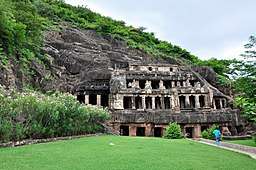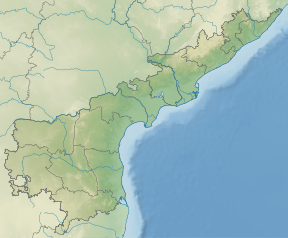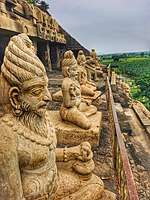Undavalli Caves
The Undavalli Caves, a monolithic example of Indian rock-cut architecture and one of the finest testimonials to ancient viswakarma sthapathis, are located in Undavalli of Guntur district in the Indian state of Andhra Pradesh. The caves are located 6 km south west from Vijayawada, 22 km north east of Guntur City of Andhra Pradesh. It is one of the centrally protected monuments of national importance.[1]
| Undavalli Caves | |
|---|---|
 The largest of the Undavalli Caves | |
  | |
| Location | Tadepalle Mandal in Guntur District, Andhra Pradesh, India |
| Discovery | 420 - 620 AD |
History
These caves are said to be found in 7th century. They are associated with the Vishnukundi kings of 420-620 CE. These caves are dedicated to Anantha Padmanabha and Lord Narashimha. Buddhist monks used these as rest houses.[2]
Chronology
These caves were carved out of solid sandstone on a hillside in the 4th to 5th centuries CE.[3] There are several caves and the best known largest one has four stories with a huge recreated statue of Vishnu in a reclining posture, sculpted from a single block of granite inside the second floor. Many Buddhist artifacts and stupas in Andhra were converted into Hindu temples and deities and undavalli is an example. It was originally a Jain cave resembling the architecture of Udayagiri and Khandgiri.[4] The main cave is one of the earliest examples of Gupta architecture, primarily primitive rock-cut monastery cells carved into the sandstone hills.[5] Initially, the caves were shaped as a Jain abode and the first-floor abode still retains the Jain style; the vihara exhibits Jain monastics and includes tirthankara sculptures. This first level of the cave is a carved vihara and includes Buddhist artwork.[6] The site served as the Bhikkhu monastic complex during ancient period.[7] The walls of the caves display sculptures carved by skilled craftsmen.
The caves are surrounded by green countryside. From the high hill above the cave overlooking the Krishna River many fine specimens of rock-cut architecture can be seen.
Architecture
It is an Impressive Four storey rock cut temple with East facing facade of 29m long, 16m wide. There are variation in depth of each floor. The ground floor is an unfinished low pillared hall with 8 pillars and 7 door openings on façade. The first storey accommodates triple shrine at back, each with the pillared hall in front, originally dedicated to the Trinity (Siva, Vishnu, and Brahma).[8]
Sculptures on the walls represent Vaishnava deities. The second storey has a pillared rectangular shrine of Lord Vishnu on a Serpent. Sculptures of Shiva and Vaishnava and a few like the Vaishnava Alwars are sculptured later on. The top floor was unfinished with a Triple Shrine. Some of the sculptural specimens are attributed to Chalukyan period. It has 5 meter long statue of Lord Buddha in reclining position.[9]
 Rock cut Hindu god in Caves.
Rock cut Hindu god in Caves. Section of Undavalli Caves.
Section of Undavalli Caves. Ganesha in the Undavalli Caves.
Ganesha in the Undavalli Caves. Sculptures of monks at Undavalli Caves.
Sculptures of monks at Undavalli Caves.
Transport
The only means of connectivity for the caves is by road. APS RTC operates bus services from Vijayawada, Guntur and Amaravathi to this location.[10] APCRDA runs Tourist Bus-cum-Boat services through Krishna River from Prakasam Barrage.[11]
Notes
- "Centrally Protected Monuments". Archeological Survey of India. Archived from the original on 26 June 2017. Retrieved 27 May 2017.
- "Vijayawada-The place of Victory/Undavalli Caves". Retrieved 6 October 2017.
- "Undavalli Caves". andhratourism.com. Retrieved 19 August 2006.
- "Undavalli Caves". showcaves.com. Retrieved 19 August 2006.
- Thapar, Binda (2004). Introduction to Indian Architecture. Singapore: Periplus Editions. p. 10. ISBN 0-7946-0011-5.
- An Official Website Of Guntur District Government Of Andhra Pradesh. "Undavalli Caves". Guntur District Government Of Andhra Pradesh. Retrieved 29 November 2013.
- Tourism Department. "Undavalli Caves". Tourism Department, Hyderabad, Andhra Pradesh, India. Retrieved 29 November 2013.
- "ASI-Rock cut Cave Temple – Undavalli". Retrieved 6 October 2017.
- "Vijayawada-The Place of Victory". Retrieved 6 October 2017.
- "Tourist Services in Guntur Region". Retrieved 6 October 2017.
- "First tourist bus-cum-boat to be functional in a week". Retrieved 6 October 2017.
External links
| Wikimedia Commons has media related to Undavalli Caves. |
